
The National Revolutionary Martyrs' Shrine, built on Chingshan Mountain in 1969, honors the war dead of the Republic of China with spirit tablets of about 390,000 persons killed during various conflicts. The shrine is surrounded by other notable historical sites, including the National Palace Museum and the Shilin Night Market, which offers a range of street food options such as Sausage Wrapped in Glutinous Rice and Oyster Omelet.
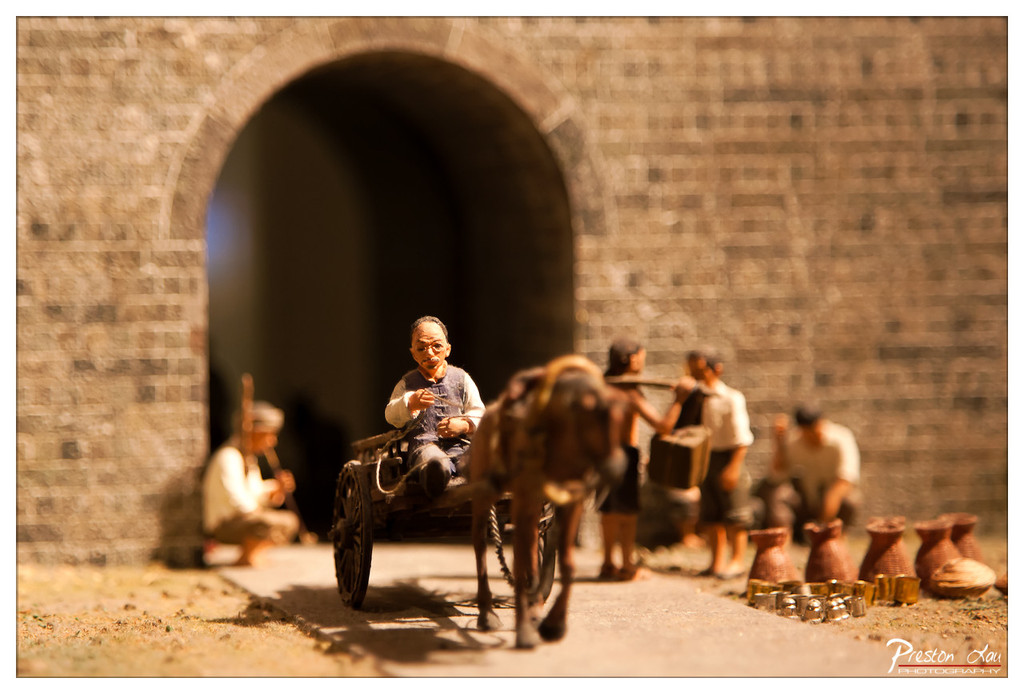

1. Overall Rating (0–10) — 7.5
This photograph masterfully blends miniature realism with atmospheric storytelling, evoking a bygone era through its meticulous craftsmanship and cinematic depth. The use of forced perspective and shallow depth of field transforms a diorama into a living scene, where the interplay of light and scale creates a sense of authenticity and quiet drama. While the technical execution is impressive, the narrative remains slightly obscured by the complexity of the scene, leaving the viewer to decipher the story rather than feel it immediately.
2. Composition (0–10) — 8.0
The central figure in the cart is well-placed, drawing the eye through the archway and into the depth of the scene. The leading lines of the path and the arch create a strong sense of movement and perspective, while the surrounding figures and objects balance the frame without overwhelming the focal point.
3. Lighting (0–10) — 8.5
The warm, directional lighting enhances the textures of the brick and earth, casting soft shadows that add dimension and realism. The light source appears to be natural, filtering through the arch and creating a dramatic contrast between light and shadow that elevates the mood.
4. Color & Tone (0–10) — 7.5
The warm, earthy palette—dominated by browns and golds—reinforces the historical and rustic tone of the scene. While the colors are cohesive, a touch more vibrancy in the highlights could enhance the overall visual impact without detracting from the authenticity.
5. Creativity (0–10) — 9.0
The concept of photographing a miniature diorama as a life-sized scene is highly original and conceptually strong. The photographer’s ability to manipulate scale and perspective transforms a static model into a dynamic narrative, demonstrating both technical skill and artistic vision.
6. Technical Quality (0–10) — 8.5
The focus is precisely managed, with the foreground subject sharply rendered while the background dissolves into a soft bokeh. The clarity and sharpness of the key elements, combined with the clean handling of depth of field, reflect a high level of technical control.
7. Emotional Impact (0–10) — 7.0
The image evokes a sense of nostalgia and quiet contemplation, inviting the viewer to imagine the lives of the people depicted. While the emotional resonance is strong, it is more intellectual than visceral—its power lies in the imagination it inspires rather than an immediate emotional pull.
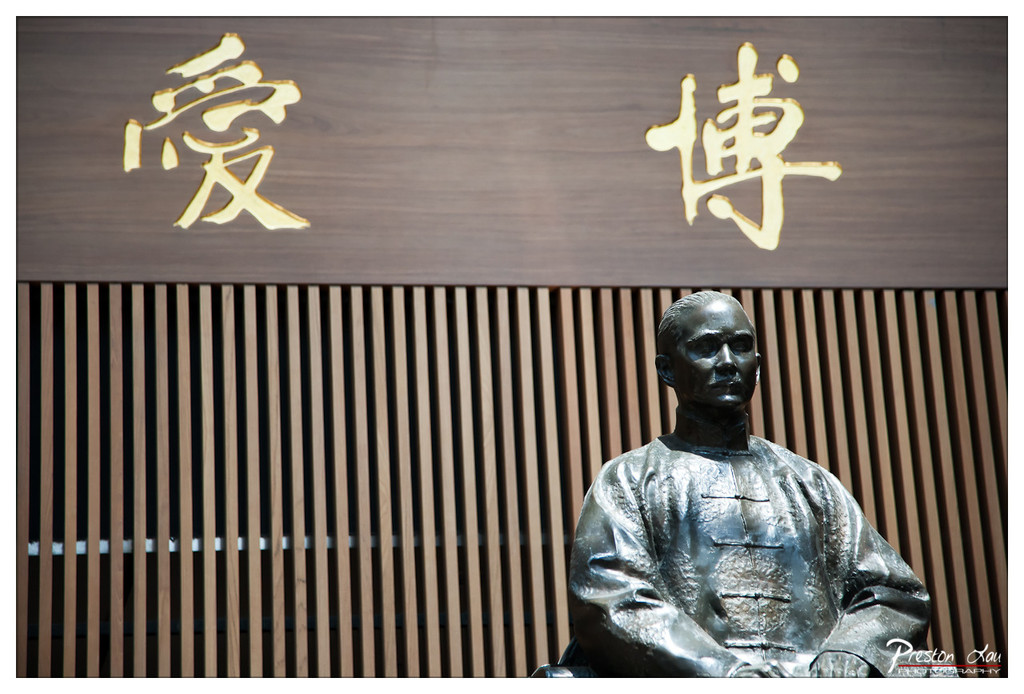

1. Overall Rating (0–10) — 7.5
This photograph captures a solemn and dignified portrait of a bronze bust set against a richly textured wooden backdrop, evoking a sense of reverence and cultural depth. The interplay of light on the statue’s surface and the golden Chinese characters above lend the image a contemplative gravitas, while the clean lines of the slatted wall provide a modern counterpoint to the traditional subject. A slightly tighter crop could enhance focus, but the composition successfully balances form, symbolism, and atmosphere.
2. Composition (0–10) — 7.0
The bust is centered with intentional symmetry, framed by the vertical slats and the horizontal placement of the calligraphy. The use of negative space above the statue draws the eye upward, emphasizing the cultural significance of the characters, though the lower portion of the frame feels slightly underutilized.
3. Lighting (0–10) — 8.0
Soft, directional lighting from the side highlights the texture and contours of the bronze, creating subtle highlights and shadows that give the sculpture a lifelike presence. The warm glow on the golden characters adds visual warmth and depth without overpowering the scene.
4. Color & Tone (0–10) — 7.5
The palette is restrained and harmonious—earthy browns, metallic grays, and golden accents create a cohesive and dignified tone. The contrast between the cool bronze and the warm wood enhances the image’s visual balance, while the lack of vibrant color reinforces its contemplative mood.
5. Creativity (0–10) — 7.0
The image effectively merges cultural symbolism with formal portraiture, using architectural elements and calligraphy to elevate the subject beyond a mere likeness. The choice to center the bust beneath the characters “愛” (love) and “博” (broad/learned) suggests a narrative of wisdom and compassion, adding conceptual depth.
6. Technical Quality (0–10) — 8.0
Sharp focus on the bust and consistent clarity throughout the image demonstrate strong technical execution. The depth of field is well-managed, keeping both the sculpture and the background characters in clear view while maintaining a clean separation.
7. Emotional Impact (0–10) — 8.0
The image conveys a quiet reverence and solemnity, inviting reflection on the legacy of the figure portrayed. The combination of tradition, craftsmanship, and thoughtful composition evokes a sense of respect and historical continuity, resonating deeply with viewers familiar with the cultural context.
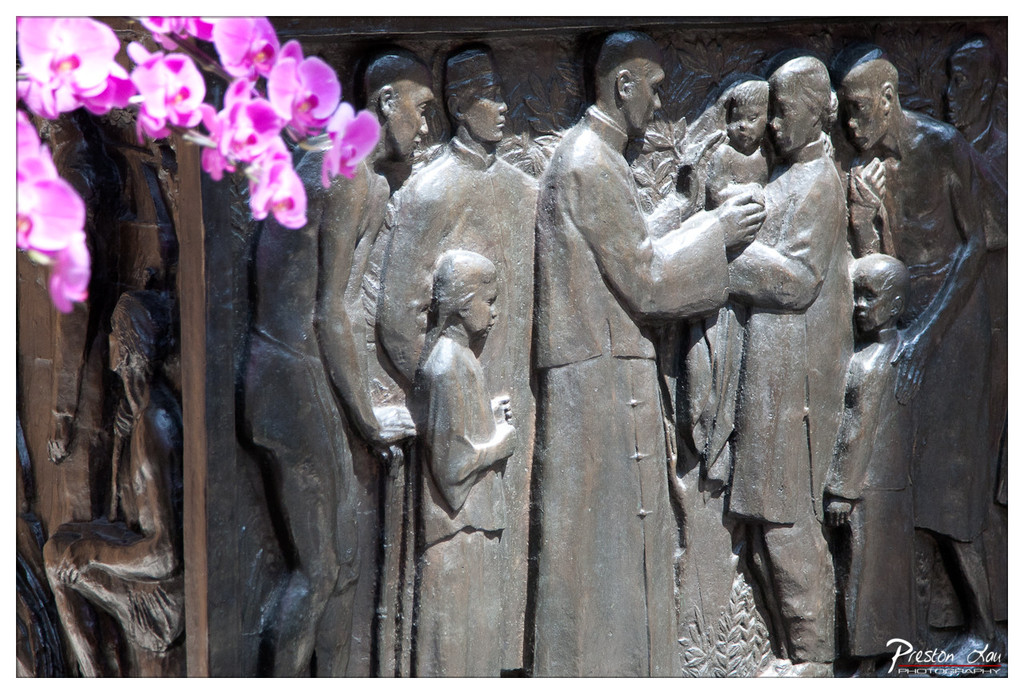

1. Overall Rating (0–10) — 7.5
This photograph masterfully juxtaposes the solemnity of a historical bronze relief with the vibrant life of blooming orchids, creating a poignant dialogue between memory and renewal. The contrast between the weathered, stoic figures and the delicate, colorful flowers adds depth and emotional resonance, transforming a simple architectural detail into a layered narrative. While the composition leans slightly toward visual clutter, the interplay of texture, color, and meaning elevates the image beyond mere documentation.
2. Composition (0–10) — 7.0
The inclusion of the orchids in the upper left corner introduces a dynamic diagonal that draws the eye into the frame, while the relief occupies the central and right portions with balanced weight. The framing is tight, focusing attention on the interaction between the sculpture and the natural element, though the intrusion of the flowers slightly disrupts the harmony of the sculptural form.
3. Lighting (0–10) — 7.5
Soft, diffused lighting enhances the texture of the bronze relief, casting subtle shadows that emphasize depth and form. The light highlights the contours of the figures without creating harsh glares, while the bright pink orchids stand out due to their natural saturation and contrast against the muted tones of the metal.
4. Color & Tone (0–10) — 8.0
The color palette is striking, with the vivid magenta of the orchids creating a powerful contrast against the monochromatic bronze. The warm tones of the flowers add a sense of vitality and hope, while the cool, earthy tones of the sculpture provide grounding and gravitas. The tonal range is well-balanced, allowing both elements to coexist without overwhelming the viewer.
5. Creativity (0–10) — 8.5
The photographer’s choice to include the orchids is highly original, transforming a static monument into a living, evolving scene. This creative juxtaposition suggests themes of continuity, healing, and the enduring presence of life amidst historical weight, making the image both visually and conceptually compelling.
6. Technical Quality (0–10) — 8.0
The image is sharp and well-focused, with clear detail visible in both the bronze relief and the delicate petals of the orchids. The depth of field is appropriately managed, ensuring both foreground and background elements remain distinct. The watermark is unobtrusive and professionally placed.
7. Emotional Impact (0–10) — 8.0
The image evokes a strong emotional response, blending reverence for the past with a sense of hope and renewal. The tender embrace of the figures in the relief, paired with the vibrant, living flowers, creates a powerful sense of continuity and resilience, inviting the viewer to reflect on the passage of time and the enduring strength of human connection.
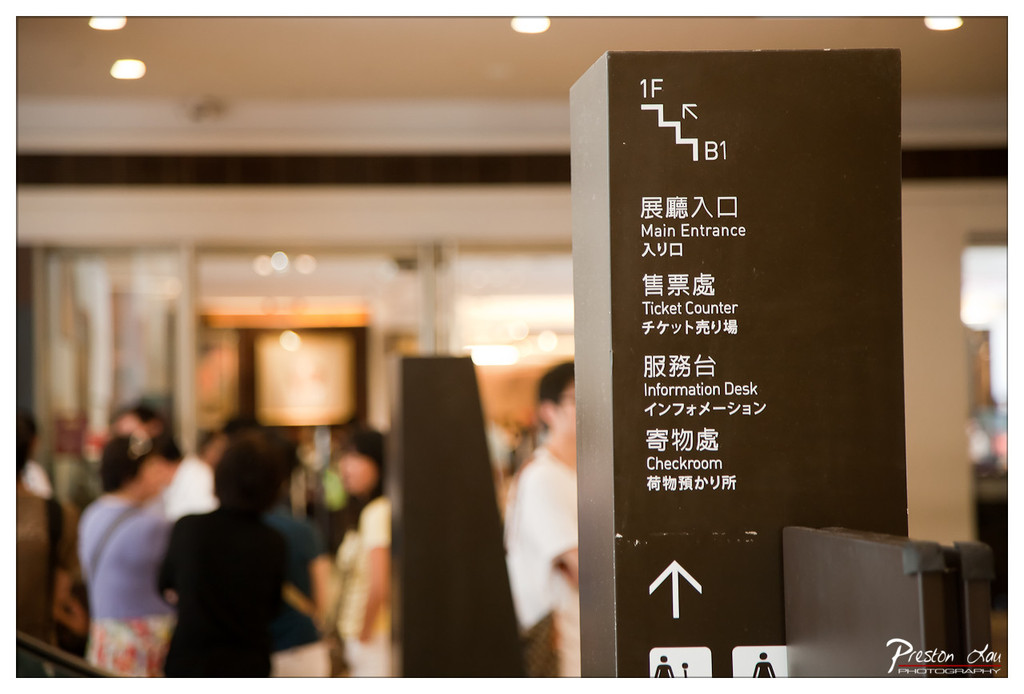

1. Overall Rating (0–10) — 6.0
This photograph captures the quiet functionality of a public space, where signage becomes the focal point of a narrative about movement and direction. The shallow depth of field draws attention to the directional sign, emphasizing its role as a guide in a bustling environment. While the image successfully isolates its subject, the lack of emotional resonance and the generic nature of the scene prevent it from feeling truly compelling.
2. Composition (0–10) — 6.5
The sign is well-placed and centered, creating a strong focal point. The blurred background adds depth and context, though the composition feels slightly static due to the rigid vertical framing.
3. Lighting (0–10) — 6.0
The lighting is soft and evenly distributed, likely from overhead artificial sources. It highlights the sign clearly without harsh shadows, though the warm tone lends a slightly flat quality to the scene.
4. Color & Tone (0–10) — 6.5
The palette is muted, dominated by earthy browns and soft whites, which complement the signage’s design. The lack of vibrant color limits visual impact, but the tonal harmony supports the image’s documentary feel.
5. Creativity (0–10) — 6.0
The use of shallow depth of field to isolate the sign from the background is a deliberate choice, but the concept is straightforward and lacks narrative surprise or conceptual depth.
6. Technical Quality (0–10) — 7.5
The focus is sharp on the sign, and the image is free of visible noise or blur. The exposure is well-balanced, and the lens choice effectively isolates the subject.
7. Emotional Impact (0–10) — 5.5
The image evokes a sense of quiet order and routine, but it doesn’t elicit a strong emotional response. The viewer is invited to observe rather than feel.
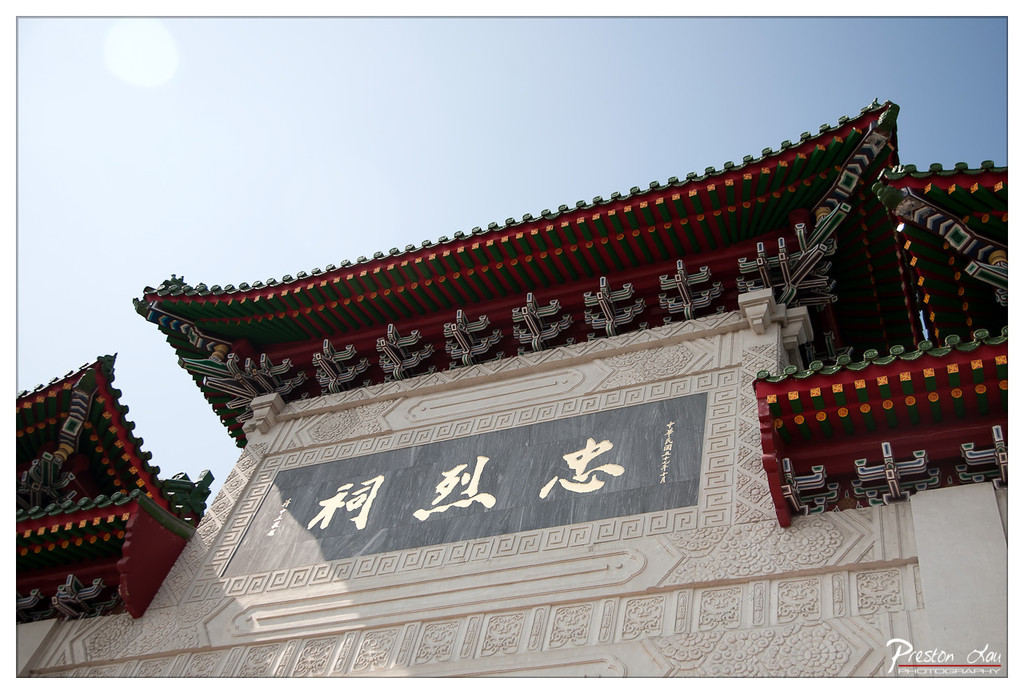

1. Overall Rating (0–10) — 7.5
This photograph captures the grandeur of a traditional Chinese architectural gateway with a striking sense of reverence and cultural weight. The low-angle perspective amplifies the monumentality of the structure, while the bold calligraphy and vibrant roof details draw the eye upward, evoking a sense of historical pride. The slight overexposure in the sky tempers the image’s emotional depth, but the composition remains compelling, balancing cultural significance with visual strength.
2. Composition (0–10) — 8.0
The low-angle shot emphasizes the building’s verticality and dominance, while the symmetrical placement of the central plaque anchors the frame. The inclusion of the roof’s ornate eaves adds layered depth, guiding the viewer’s gaze across the rich textures and details.
3. Lighting (0–10) — 6.5
The bright, direct sunlight enhances contrast and highlights the intricate carvings, but the overexposed sky and lens flare reduce tonal subtlety. The harsh light flattens some shadows, diminishing the sense of three-dimensionality.
4. Color & Tone (0–10) — 7.0
The deep reds and greens of the roof tiles create a bold, traditional palette that contrasts beautifully with the pale stone. The overall tone is clean and clear, though the slightly cool white balance tempers the warmth of the scene.
5. Creativity (0–10) — 7.5
The photographer’s choice of angle and focus on cultural elements demonstrates a strong narrative intent. The image transcends mere documentation, framing the structure as a symbol of enduring values and heritage.
6. Technical Quality (0–10) — 8.0
The image is sharp and well-focused, with fine detail visible in the stonework and calligraphy. The exposure is generally well-managed, aside from the bright sky, and the watermark is discreet.
7. Emotional Impact (0–10) — 7.0
The photograph evokes a quiet sense of awe and respect, inviting the viewer to reflect on the historical and cultural weight of the site. The strong visual presence of the structure creates a lasting impression of dignity and tradition.
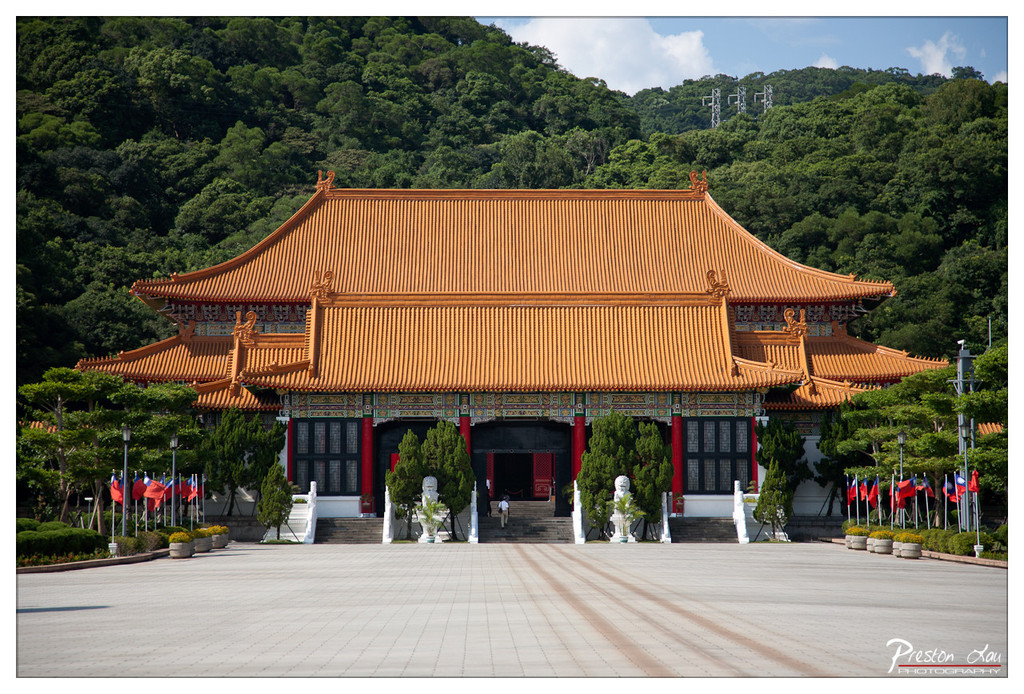

1. Overall Rating (0–10) — 8.0
This photograph captures the grandeur of a traditional East Asian temple with striking clarity and balance, where architectural symmetry meets natural serenity. The vibrant orange roof contrasts beautifully against the lush green hillside, creating a visually harmonious composition that evokes both reverence and tranquility. While the scene is rich in cultural and aesthetic detail, the absence of human presence lends a slightly impersonal air, softening its emotional immediacy.
2. Composition (0–10) — 9.0
The symmetrical framing centers the temple perfectly, drawing the eye along the wide plaza toward the entrance. The leading lines of the pavement and the flanking rows of flags guide the viewer’s gaze naturally, while the surrounding trees and hillside provide a natural frame that enhances the sense of scale and order.
3. Lighting (0–10) — 8.0
Bright, natural daylight illuminates the scene evenly, highlighting the texture of the tiles and the rich colors of the structure. The soft shadows under the eaves add depth without obscuring detail, and the clear blue sky contributes to the image’s clarity and openness.
4. Color & Tone (0–10) — 8.5
The warm, golden-orange of the roof contrasts powerfully with the deep greens of the forest and the crisp white of the pillars, creating a bold yet balanced palette. The tonal range is strong, with rich saturation that enhances the visual drama without appearing overprocessed.
5. Creativity (0–10) — 7.5
While the image is technically masterful and compositionally strong, its creativity lies more in its documentation than in its conceptual innovation. The photograph captures a familiar subject with a fresh sense of balance and clarity, but it doesn’t push beyond the expected visual narrative.
6. Technical Quality (0–10) — 9.0
The image is sharp and well-focused throughout, with excellent detail in both the foreground and background. The depth of field is appropriate, and there are no visible flaws in exposure or noise, reflecting high technical execution.
7. Emotional Impact (0–10) — 7.0
The image evokes a sense of peace and awe, inviting contemplation of cultural heritage and natural beauty. The stillness of the plaza and the quiet dignity of the temple create a meditative mood, though the lack of human activity limits the emotional connection for some viewers.
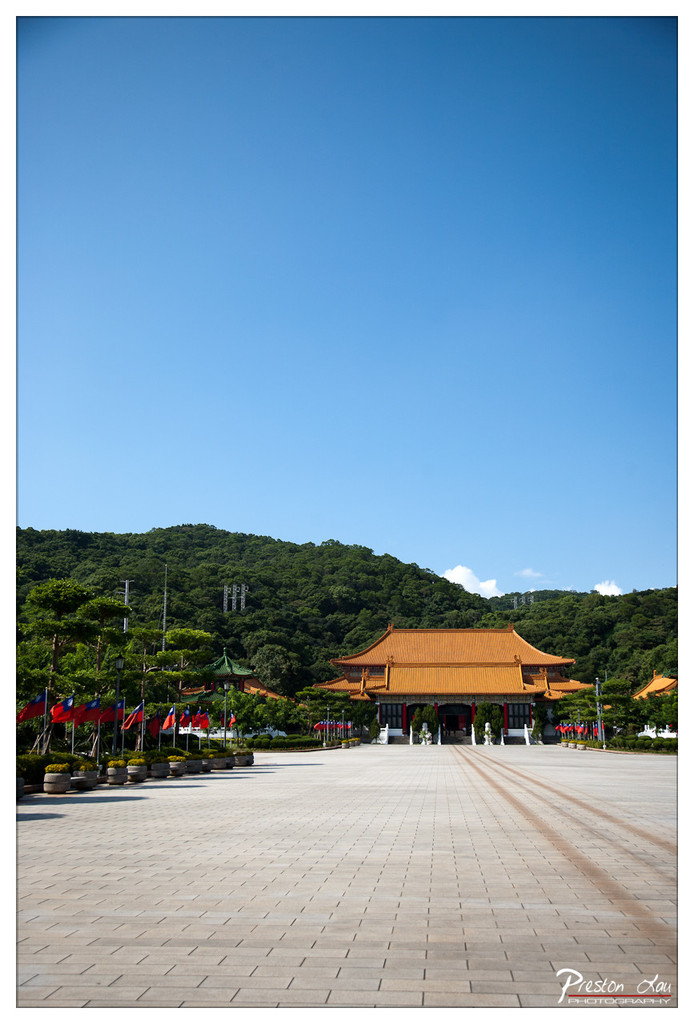

1. Overall Rating (0–10) — 7.5
This photograph captures the grandeur of a traditional East Asian temple set against a vast, cloudless sky, evoking a sense of peace and cultural reverence. The expansive courtyard and symmetrical framing draw the eye toward the ornate structure, while the vibrant orange roof contrasts beautifully with the deep green hill and azure expanse. Though the scene is visually striking, the lack of human presence lends a slightly sterile quality, softening its emotional resonance.
2. Composition (0–10) — 8.0
The strong leading lines of the paved courtyard guide the viewer’s gaze toward the central temple, creating a powerful sense of depth and symmetry. The low-angle perspective enhances the building’s scale, while the balanced framing of the temple between the flanking flags and trees contributes to a harmonious, monumental feel.
3. Lighting (0–10) — 8.5
Bright, natural sunlight illuminates the scene evenly, highlighting the temple’s golden roof and casting soft shadows that add dimension. The clear blue sky enhances the contrast and vibrancy, creating a crisp, vivid atmosphere that underscores the clarity of the day.
4. Color & Tone (0–10) — 8.0
The palette is rich and balanced, with the warm orange of the temple roof standing out against the cool blue sky and lush green foliage. The tonal range is wide, with deep shadows and bright highlights contributing to a dynamic yet cohesive visual experience.
5. Creativity (0–10) — 7.0
The image presents a classic architectural subject with a strong sense of place, but its adherence to traditional composition limits its originality. The use of symmetry and formal framing is effective, yet it leans toward documentation rather than bold artistic interpretation.
6. Technical Quality (0–10) — 8.5
The photograph is sharp and well-focused, with excellent clarity in the textures of the pavement, roof tiles, and foliage. The exposure is well-managed, preserving detail in both highlights and shadows, and the resolution is high.
7. Emotional Impact (0–10) — 7.5
The image conveys a sense of tranquility and reverence, inviting contemplation of cultural heritage and natural beauty. While it lacks a personal or narrative element, its visual power and serene mood foster a quiet emotional connection with the viewer.
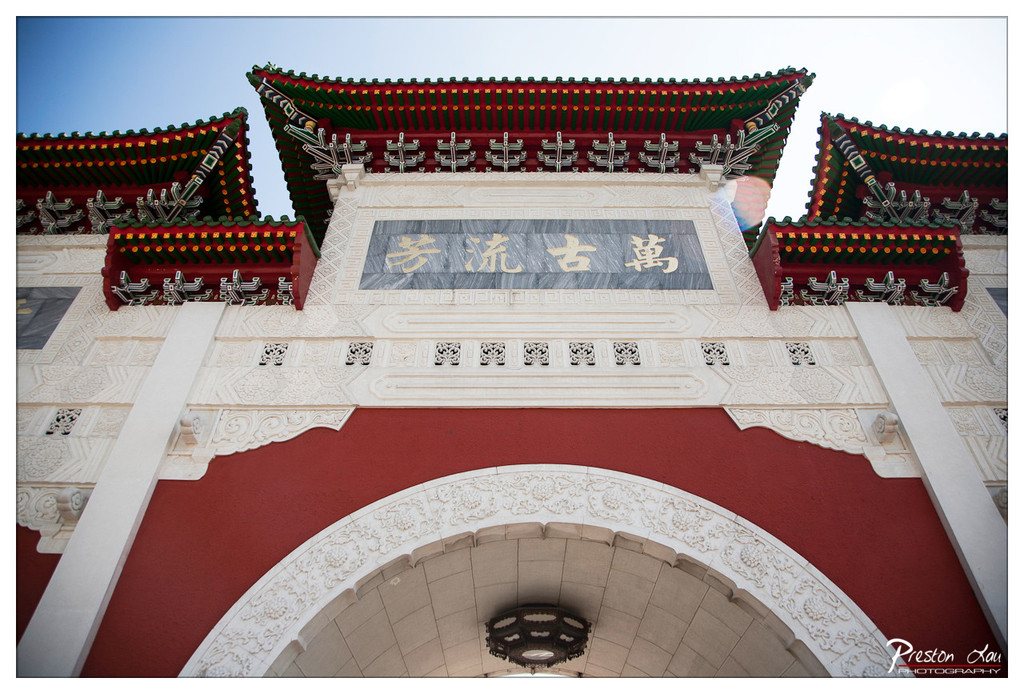

1. Overall Rating (0–10) — 8.0
This photograph captures the grandeur and cultural richness of a traditional Chinese architectural gateway with striking clarity and reverence. The low-angle perspective emphasizes the monument’s imposing scale, while the interplay of red, green, and white evokes a sense of imperial dignity. Though the composition is strong and the subject compelling, a slightly more dynamic sky or subtle atmospheric depth could elevate the image from impressive to transcendent.
2. Composition (0–10) — 8.5
The low-angle framing centers the arch and calligraphy, creating a strong sense of symmetry and verticality. The inclusion of the ornate roofline and decorative elements guides the eye upward, enhancing the structure’s majestic presence. The arch frames the interior space, adding depth and inviting the viewer into the scene.
3. Lighting (0–10) — 7.5
Natural daylight illuminates the façade evenly, highlighting the intricate carvings and bold colors. The soft shadows under the eaves add dimension without overpowering the scene. A slight lens flare adds a touch of warmth and authenticity, though it slightly distracts from the central calligraphy.
4. Color & Tone (0–10) — 8.0
The vibrant red and green contrast beautifully against the white stone, creating a bold and culturally resonant palette. The warm tones enhance the structure’s regal feel, while the subtle desaturation of the sky provides a neutral backdrop that allows the architecture to dominate.
5. Creativity (0–10) — 7.5
The photographer’s choice of angle and framing emphasizes both the architectural detail and symbolic significance of the structure. The inclusion of the calligraphic inscription adds narrative depth, transforming the image from a mere architectural record into a cultural statement.
6. Technical Quality (0–10) — 8.5
Sharp focus across the frame captures fine textures in the stone and roof tiles. The exposure is well-balanced, and the image is free from noise or distortion. The watermark is discreet and does not interfere with the composition.
7. Emotional Impact (0–10) — 7.0
The image evokes a sense of awe and respect for cultural heritage, inviting viewers to reflect on the historical and artistic significance of the structure. While the emotional resonance is strong, it remains more intellectual than visceral, leaving the viewer in admiration rather than deep emotional connection.
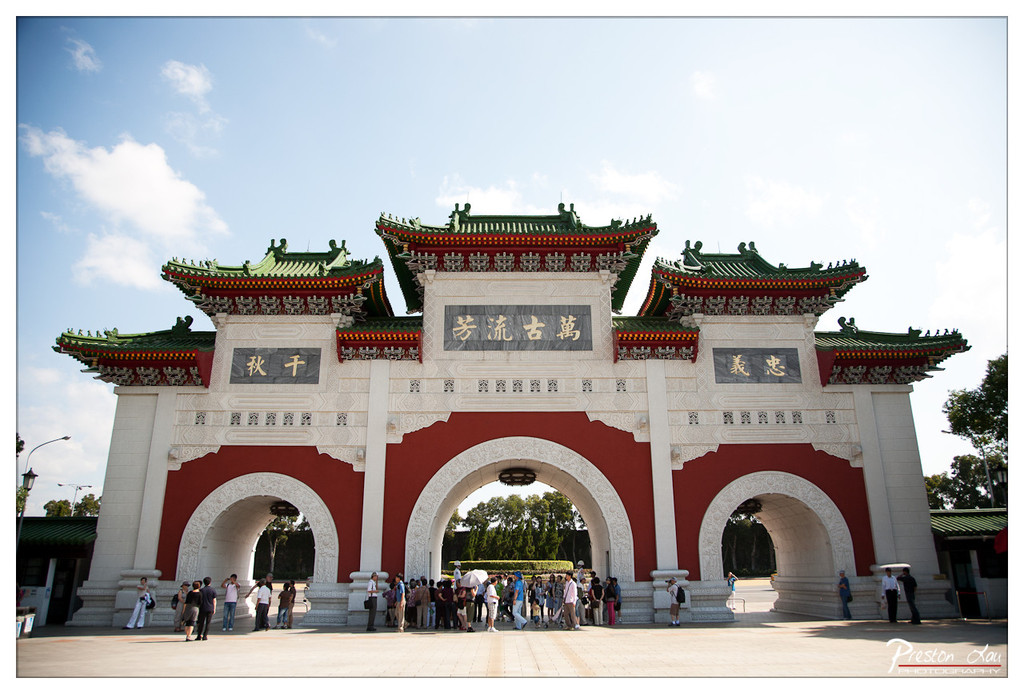

1. Overall Rating (0–10) — 7.5
This photograph captures the grandeur of the Chiang Kai-shek Memorial Hall with a striking balance of architectural majesty and human presence. The bold red and white tones, combined with the sweeping green roofs, create a visually commanding structure that feels both solemn and celebratory. While the composition is strong, the presence of tourists slightly detracts from the monument’s intended reverence, and the sky’s overexposure lends a slight flatness to the scene.
2. Composition (0–10) — 8.0
The symmetrical framing centers the archway perfectly, emphasizing the monument’s architectural harmony. The people at the base add scale and context, grounding the image in reality, though their distribution feels slightly crowded on the left.
3. Lighting (0–10) — 7.0
Bright daylight illuminates the structure clearly, highlighting its intricate details and vibrant colors. However, the sky is slightly overexposed, washing out subtle cloud textures and reducing atmospheric depth.
4. Color & Tone (0–10) — 8.0
The rich reds and greens of the building stand out against the pale sky and white stone, creating a powerful contrast. The color palette feels authentic and culturally resonant, though the tones are slightly oversaturated, giving the image a slightly artificial edge.
5. Creativity (0–10) — 7.0
The image effectively documents a landmark with a clear artistic intent—highlighting both its cultural significance and its role as a public space. The inclusion of people adds narrative depth, though the approach is conventional rather than experimental.
6. Technical Quality (0–10) — 8.5
Sharp focus and clean detail across the frame demonstrate strong technical execution. The lens choice and depth of field are well-suited to the subject, capturing both foreground and background with clarity.
7. Emotional Impact (0–10) — 7.5
The photograph evokes a sense of awe and national pride, enhanced by the monument’s scale and the quiet dignity of the setting. The human element introduces a touch of everyday life, creating a subtle emotional bridge between the past and present.
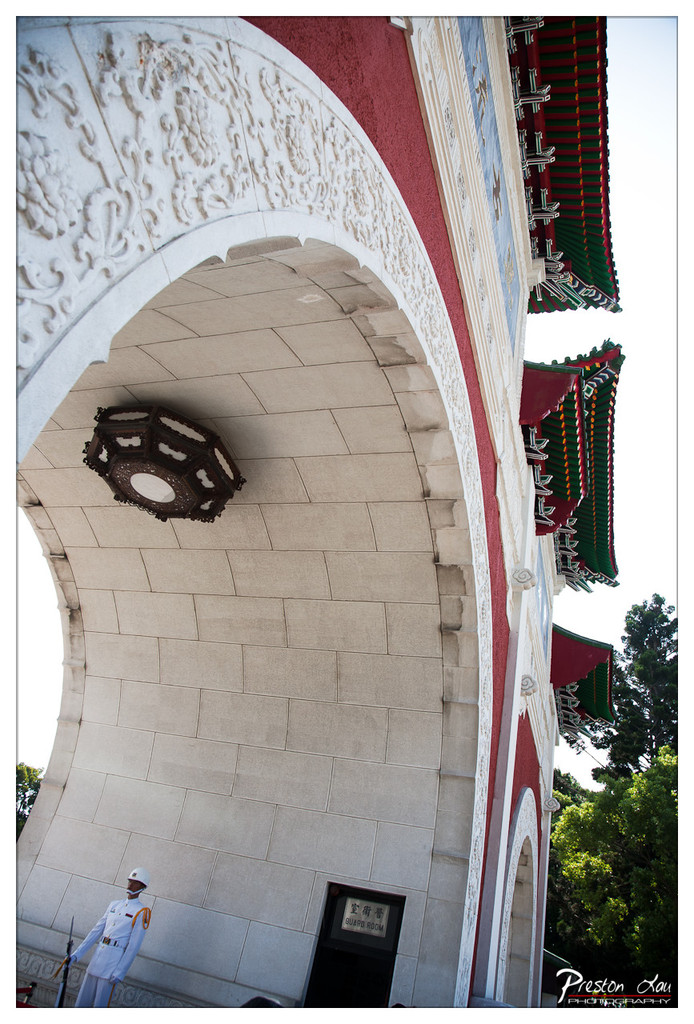

1. Overall Rating (0–10) — 7.5
This photograph captures the solemn grandeur of a historic monument with striking architectural detail and a sense of ceremonial stillness. The low-angle perspective emphasizes the monument’s scale, while the crisp focus on the guard and ornate stonework adds narrative weight. The composition balances tradition and formality, though the bright sky slightly overexposes the upper portion, reducing tonal depth.
2. Composition (0–10) — 8.0
The strong diagonal lines of the arch and roof create dynamic tension, guiding the eye through the frame. The guard’s placement at the lower left offers a human anchor, balancing the ornate architecture and reinforcing the monument’s ceremonial purpose.
3. Lighting (0–10) — 7.0
Natural daylight enhances the texture of the stone and highlights the intricate carvings. However, the overexposed sky and harsh contrast between the bright background and shadowed arch reduce tonal subtlety and create a slight visual imbalance.
4. Color & Tone (0–10) — 7.5
The palette of red, green, and white reflects the building’s traditional design with clarity and cultural resonance. The neutral tones of the stone provide a calm backdrop, though the overall color balance leans slightly cool, dampening the warmth of the scene.
5. Creativity (0–10) — 8.0
The photographer’s choice of a low angle and inclusion of the guard injects narrative into the architectural subject, transforming a static monument into a living symbol of tradition and duty.
6. Technical Quality (0–10) — 8.0
Sharp focus, clean detail, and good exposure control in the main subject area demonstrate strong technical execution. The slight overexposure in the sky is the primary technical limitation.
7. Emotional Impact (0–10) — 8.0
The image evokes reverence and quiet dignity, capturing a moment of ceremonial stillness that resonates with historical weight and cultural significance. The viewer is drawn into a contemplative space of respect and permanence.
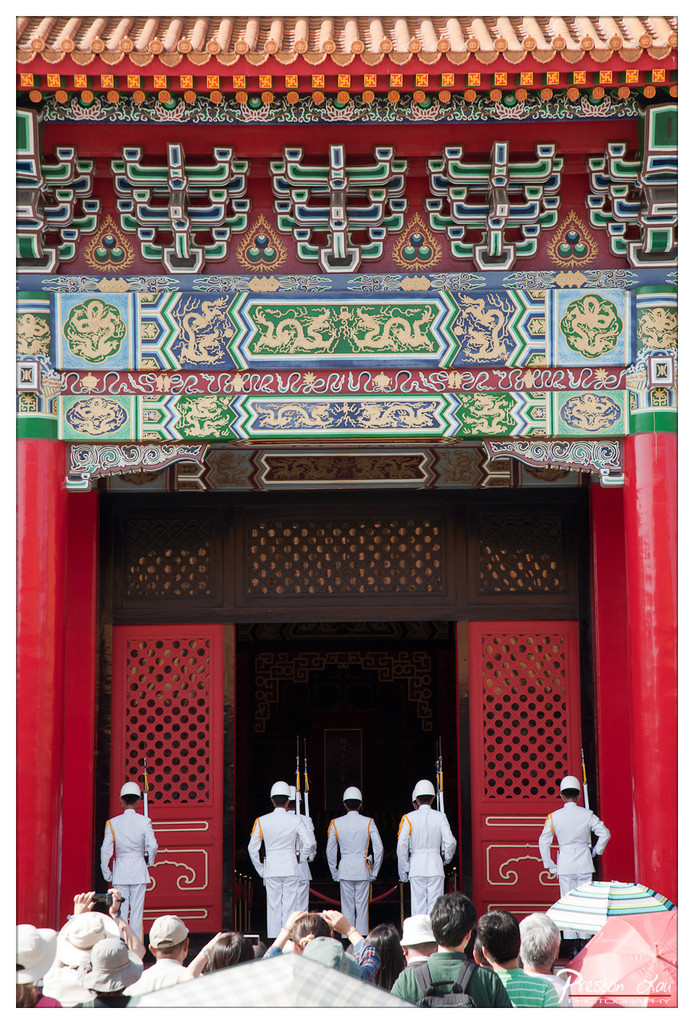

1. Overall Rating (0–10) — 8.0
This photograph captures a striking moment of cultural ceremony, where tradition and discipline converge beneath the ornate facade of a historic gate. The vibrant reds and intricate dragon motifs create a powerful sense of grandeur, while the uniformed guards and onlookers lend a human scale to the scene. The image balances architectural splendor with the quiet dignity of ritual, though the crowded foreground slightly dilutes the visual focus.
2. Composition (0–10) — 7.5
The symmetrical framing of the gate and guards creates a strong central axis, drawing the eye toward the entrance. However, the inclusion of the crowd in the lower third introduces visual clutter, slightly disrupting the formal balance.
3. Lighting (0–10) — 8.0
Natural daylight enhances the vividness of the colors and highlights the architectural details. The even illumination across the façade emphasizes the ornate carvings and painted patterns without harsh shadows.
4. Color & Tone (0–10) — 9.0
The rich reds, golds, and greens of the traditional design create a bold and harmonious palette. The contrast between the ceremonial whites of the uniforms and the deep reds of the structure enhances visual impact, while the warm tones evoke a sense of imperial heritage.
5. Creativity (0–10) — 7.5
The image captures a moment of cultural authenticity with a strong sense of narrative. The juxtaposition of the ancient architecture with the modern presence of tourists adds a layer of contemporary context, though the composition leans more toward documentation than artistic interpretation.
6. Technical Quality (0–10) — 8.5
Sharp focus on the central subjects and clean detail throughout the frame indicate strong technical execution. The depth of field effectively isolates the guards and gate, while the clarity of the intricate patterns showcases excellent resolution.
7. Emotional Impact (0–10) — 7.5
The image conveys a sense of reverence and awe, evoking the solemnity of a ceremonial tradition. The presence of the crowd, some with cameras, suggests shared wonder, inviting viewers to reflect on the enduring power of cultural heritage.
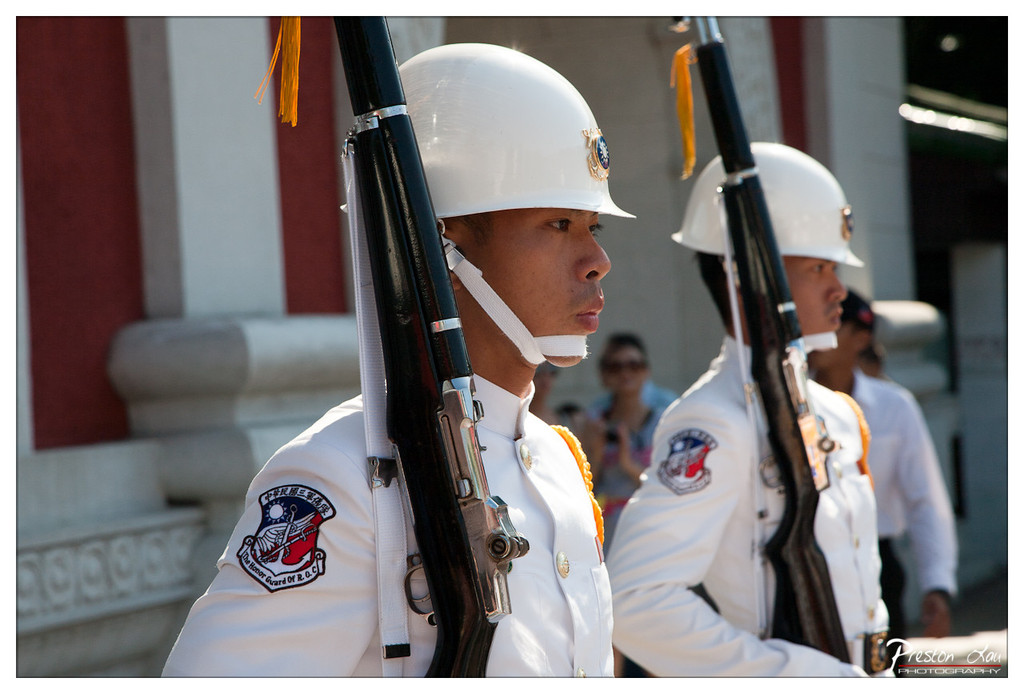

1. Overall Rating (0–10) — 7.5
This photograph captures the solemnity and precision of a ceremonial military procession, with crisp focus and a strong sense of discipline conveyed through the soldiers' posture and uniform. The composition draws the viewer into the line of march, emphasizing unity and tradition. While the background elements add context, they slightly distract from the central figures, and the lighting, though bright, flattens some of the subtle textures in the uniforms.
2. Composition (0–10) — 7.0
The diagonal alignment of the soldiers creates a strong sense of movement and rhythm, leading the eye through the frame. The shallow depth of field isolates the foreground subject, though the inclusion of the background figures and onlookers adds narrative depth at the cost of compositional purity.
3. Lighting (0–10) — 7.5
Bright, natural daylight illuminates the scene evenly, highlighting the white uniforms and crisp details of the ceremonial gear. The light direction enhances the texture of the fabric and the reflective surfaces of the helmets and rifles, though slight overexposure in the highlights slightly reduces tonal range.
4. Color & Tone (0–10) — 7.0
The dominant white and navy blue of the uniforms create a clean, formal palette, with the red and yellow accents on the helmet tassels and patch adding visual contrast. The color balance is natural, though the tones lean slightly cool, which may diminish the warmth of the moment.
5. Creativity (0–10) — 7.5
The image successfully blends documentary realism with a sense of ceremonial grandeur, capturing a moment that feels both authentic and staged. The focus on the soldier’s expression and the alignment of the rifles convey a narrative of honor and duty.
6. Technical Quality (0–10) — 8.0
Sharp focus on the main subject, precise exposure, and clean detail throughout the frame reflect strong technical execution. The camera’s ability to capture fine textures—such as the insignia and strap—adds to the image’s clarity and professionalism.
7. Emotional Impact (0–10) — 7.0
The photograph evokes a sense of respect and solemnity, with the soldiers’ focused expressions and disciplined stance conveying a powerful emotional weight. The viewer is invited to reflect on the gravity of ceremonial duty, though the emotional connection is tempered by the image’s objective, almost detached, framing.
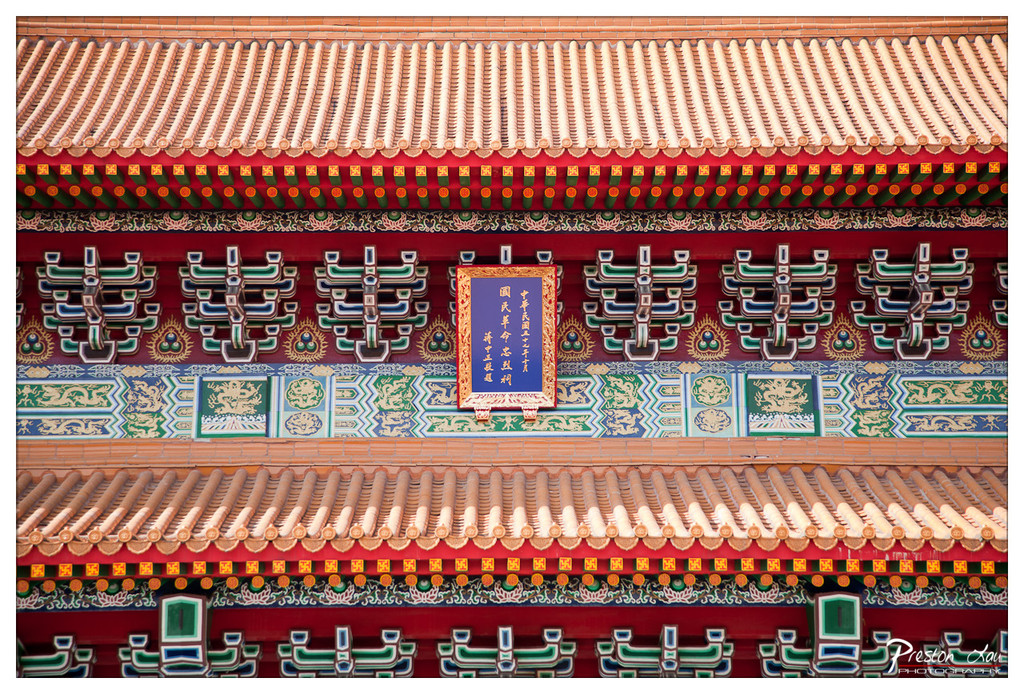

1. Overall Rating (0–10) — 8.0
This photograph captures the ornate grandeur of traditional Chinese architecture with striking clarity and cultural resonance. The rich colors and intricate patterns evoke a sense of historical depth and craftsmanship, while the symmetrical composition grounds the image in visual harmony. A slight overexposure in the roof tiles tempers the overall impact, but the image remains a compelling celebration of architectural artistry.
2. Composition (0–10) — 8.5
The symmetrical framing emphasizes balance and order, drawing the eye to the central plaque as a focal point. The layered horizontal bands of tile, ornamentation, and color create rhythm and depth, reinforcing the architectural complexity.
3. Lighting (0–10) — 7.5
Natural light enhances the vibrancy of the colors, particularly the reds and golds, while soft shadows add dimension to the relief details. However, some highlights on the glazed tiles appear slightly washed out, reducing subtle texture.
4. Color & Tone (0–10) — 9.0
The palette is rich and deliberate, with bold reds, greens, and golds creating a visually dynamic and culturally authentic atmosphere. The contrast between warm and cool tones enhances the sense of depth and craftsmanship.
5. Creativity (0–10) — 8.0
The image successfully transforms an architectural detail into a compelling visual narrative, emphasizing cultural symbolism and design repetition. The choice to focus on the central plaque introduces a narrative element, inviting interpretation.
6. Technical Quality (0–10) — 8.5
Sharp focus and clean detail reveal the fine craftsmanship of the carvings and tiles. The exposure is generally well-managed, though minor overexposure in highlights slightly diminishes tonal range.
7. Emotional Impact (0–10) — 8.0
The image evokes reverence and awe, capturing the enduring beauty and cultural weight of a historic structure. Its meticulous design invites contemplation, connecting the viewer to a sense of tradition and legacy.
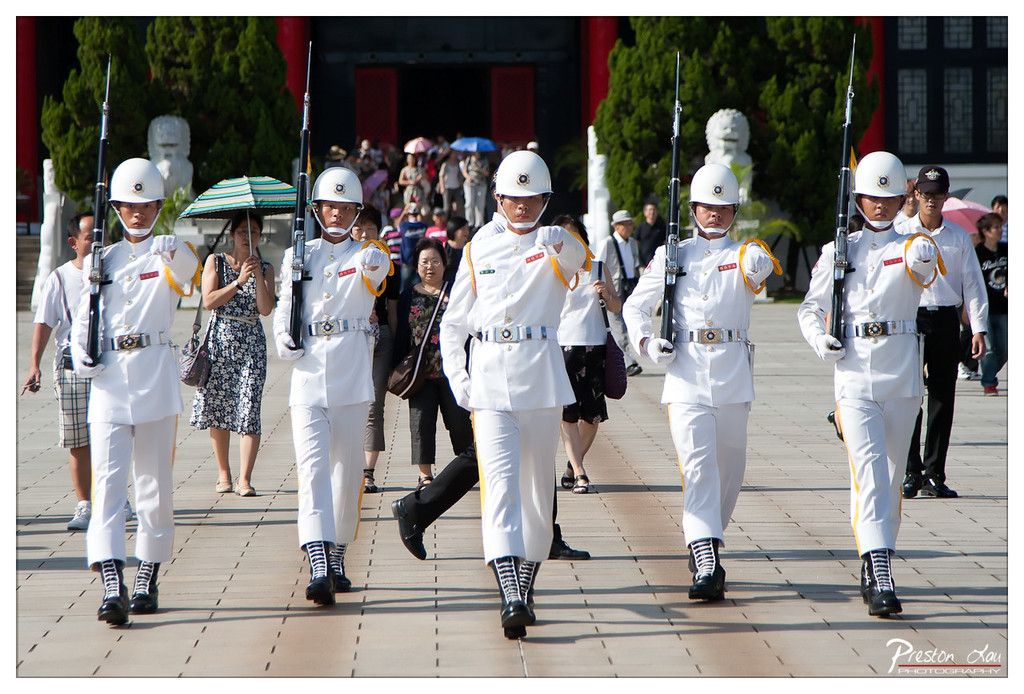

1. Overall Rating (0–10) — 7.0
This photograph captures a striking ceremonial procession, where the disciplined precision of uniformed soldiers contrasts with the casual presence of onlookers. The bright sunlight and bold white uniforms create a visually arresting scene, emphasizing the formality of the event. While the image succeeds in conveying the energy and pageantry of the moment, the background distractions slightly diminish its overall impact.
2. Composition (0–10) — 6.5
The soldiers are well-framed in a diagonal line, creating a sense of movement and direction. However, the presence of tourists and umbrellas in the background introduces visual clutter, pulling focus from the central subjects.
3. Lighting (0–10) — 8.0
Strong, direct sunlight enhances the crispness of the white uniforms and casts sharp shadows, adding depth and clarity. The high contrast emphasizes the formality and precision of the scene.
4. Color & Tone (0–10) — 7.0
The dominant white of the uniforms contrasts effectively with the earthy tones of the pavement and the green of the trees. The color palette is balanced, though slightly washed out by the bright daylight, reducing subtlety in the midtones.
5. Creativity (0–10) — 7.5
The juxtaposition of formal military display and casual civilian observers adds a layer of narrative depth. The photographer captures a moment where tradition and everyday life intersect, offering a compelling cultural snapshot.
6. Technical Quality (0–10) — 8.0
The image is sharp, with clear focus on the soldiers in the foreground. The depth of field is well-managed, though some background elements remain slightly out of focus, which is appropriate for the scene.
7. Emotional Impact (0–10) — 7.0
The photograph evokes a sense of awe and respect for the ceremonial tradition, while also hinting at the underlying normalcy of daily life. The emotional resonance lies in the contrast between order and spontaneity, inviting reflection on public rituals and their place in society.
Loading map...